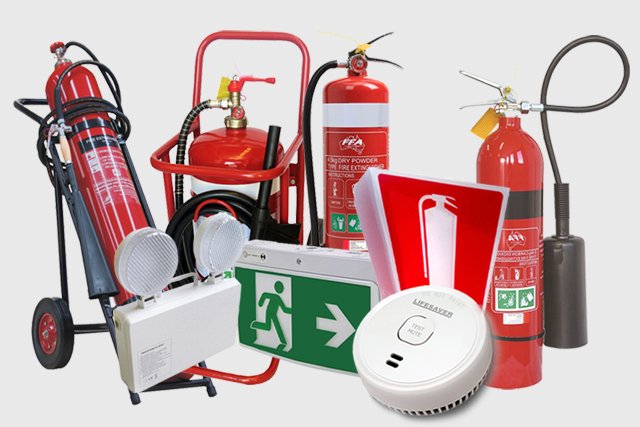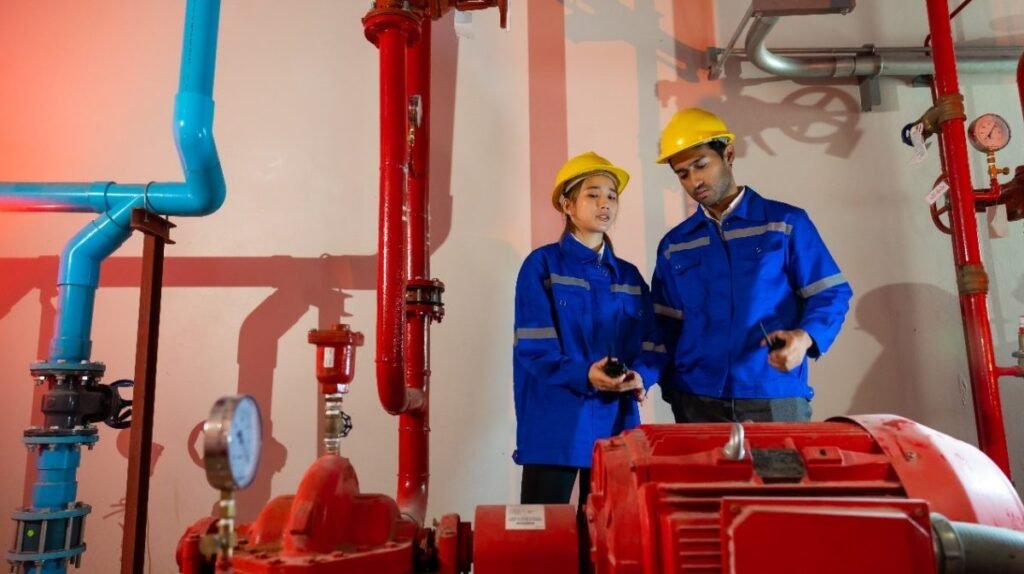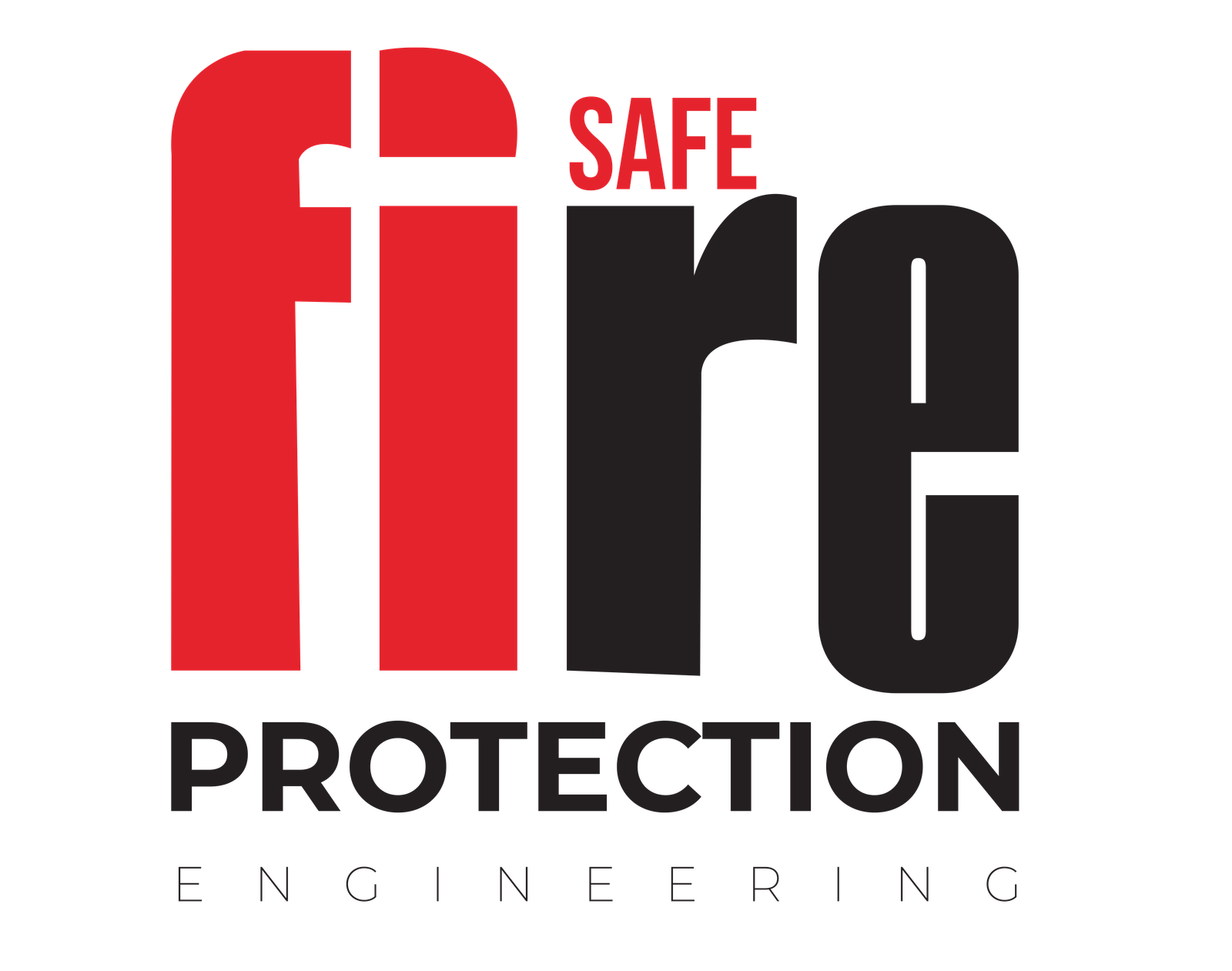What are the Different Types of Fire Protection Systems for Buildings?
The different types of fire protection systems are essential for designing safe environments that effectively prevent and control fire hazards. Fire protection systems are essential safety measures designed to detect, control, and suppress fires, safeguarding both lives and property. In modern construction, these systems are a legal requirement in most jurisdictions and a critical element of building safety planning. Fire protection systems can be broadly categorized into active and passive types, each serving a distinct role in fire safety.
At Safe Fire Protection Engineering, we design and install systems tailored to each building’s risk profile.
Types of Fire Protection Systems and Their Key Benefits
Fire protection systems come in several forms, each with unique advantages:
- Fire Sprinkler Systems
- How they work: Automatically discharge water when heat from a fire activates the sprinkler head.
- Benefits: Quick response, high effectiveness in controlling flames, and proven ability to reduce fire damage.
- Fire Suppression Systems
- How they work: Use agents such as foam, gas, or chemicals instead of water to suppress fires, making them ideal for sensitive equipment areas like data centers.
- Benefits: Minimal water damage, rapid fire control, and suitability for specialized hazards.
- Fire Alarm and Detection Systems
- How they work: Detect smoke, heat, or flame and trigger alarms to alert occupants and emergency responders.
- Benefits: Early warning allows faster evacuation and emergency response, potentially preventing fire escalation.
- Smoke Control and Ventilation Systems
- How they work: Remove smoke and toxic gases from a building during a fire.
- Benefits: Improves visibility during evacuation, reduces inhalation risks, and aids firefighters in locating and extinguishing the fire.
- Passive Fire Protection (PFP) Measures
- How they work: Include fire-resistant walls, doors, floors, and coatings that contain or slow fire spread.
- Benefits: Compartmentalizes fire, protects structural integrity, and buys time for evacuation and firefighting efforts.

How Do Active Fire Protection Systems Differ from Passive Fire Protection Systems?
- Active Fire Protection (AFP):
These systems require some form of action to work—either automatic activation (sprinklers, detectors) or manual activation (fire extinguishers). Their primary function is to detect and suppress a fire quickly.- Examples: Sprinkler systems, fire alarms, suppression systems, fire extinguishers.
- Passive Fire Protection (PFP):
These systems are built into the structure and do not require activation. They work by containing fires and preventing their spread through fire-resistant materials and compartmentalization.- Examples: Fire-rated walls and doors, fireproof coatings, structural fire protection, fire-stopping materials.
Key Difference: AFP actively responds to a fire to stop it, while PFP passively resists fire spread and protects the building’s integrity. In a complete fire safety strategy, both systems are used together.
Safe Fire Protection Engineering integrates both for maximum safety.
From Sprinklers to Suppression: Types of Fire Protection Systems
A comprehensive building safety plan may include:
- Wet Pipe Sprinkler Systems: Always contain water in the pipes, allowing immediate discharge when activated.
- Dry Pipe Sprinkler Systems: Pipes contain pressurized air or nitrogen, releasing water only when a sprinkler head opens. Ideal for cold environments.
- Deluge Systems: All heads release water simultaneously—used in high-hazard areas.
- Pre-Action Systems: Require a two-step activation to prevent accidental discharge, useful in areas with sensitive contents.
- Gas Suppression Systems: Use clean agents like FM-200 or CO₂ to extinguish fires without water.
- Foam Systems: Used for flammable liquid fires in industrial or storage facilities.

What Types of Fire Protection Systems Are Used in Commercial Buildings?
Commercial buildings—such as offices, shopping centers, hospitals, and warehouses—typically integrate multiple fire protection systems for maximum coverage:
- Automatic Sprinkler Systems for rapid suppression.
- Addressable Fire Alarm Systems for precise fire location identification.
- Gas-Based Suppression in server rooms or archives.
- Smoke Extraction and Ventilation Systems in Large Halls and Underground Parking Areas.
- Fire-rated compartments to limit the spread between floors and sections.
- Emergency Lighting and Exit Signage to aid safe evacuation.
At Safe Fire Protection Engineering, we select systems based on building function, occupancy, and risk level.
Types of Fire Protection Systems and Their Role in Fire Safety
Fire protection systems generally fall into two main categories—active and passive.
- Active Fire Protection (AFP): Includes systems like sprinklers, suppression systems, fire alarms, and detectors. These require action—automatic or manual—to detect, alert, and control fires.
- Passive Fire Protection (PFP): Built into the structure, such as fire-resistant walls, floors, and doors. Their role is to contain a fire, prevent its spread, and protect the building’s structural integrity.
Each type plays a unique role: AFP focuses on immediate detection and control, while PFP ensures containment and safety during evacuation.
Reducing Fire Risks with Effective Safety Solutions
- Sprinkler & Suppression Systems: Directly attack the fire source, reducing heat, smoke, and spread.
- Detection & Alarm Systems: Provide early warning, enabling faster evacuation and emergency response.
- Smoke Control Systems: Improve visibility and reduce toxic inhalation risks.
- Passive Barriers: Slow fire spread, giving occupants and firefighters more time to act.
By combining these measures, the probability of a fire escalating into a large-scale disaster is greatly reduced.

Maintenance Tips to Keep Fire Safety Equipment in Top Shape
Regardless of type, all fire protection systems require routine care:
- Monthly: Check control valves, fire extinguishers, and alarms for visible damage or obstruction.
- Quarterly: Test alarms, sprinklers, and suppression system controls; inspect water supplies and pumps.
- Annually: Conduct a full system inspection by certified professionals; update building fire safety plans.
- Passive Systems: Inspect fire doors, wall penetrations, and firestopping materials for damage or compromise.
Proactive maintenance ensures that systems function correctly during an emergency and extends their lifespan. Safe Fire Protection Engineering offers comprehensive maintenance services to keep your fire protection systems in top condition—providing you with peace of mind that your building is always ready to respond to a fire emergency.
Comparing the Costs of Various Fire Protection Options
Fire protection systems are a vital investment for any building—residential, commercial, or industrial. Their role extends far beyond compliance; they are critical to saving lives, preserving property, and maintaining business continuity.
Initial installation costs vary depending on the system type, building size, and hazard level:
- Wet Pipe Sprinkler Systems: ৳120–৳240 per square foot. Reliable and low-maintenance, but not ideal for freezing conditions.
- Dry Pipe Sprinkler Systems: ৳240–৳480 per square foot. Higher cost due to added components and air pressure systems.
- Deluge Systems: ৳480–৳960 per square foot. Used in high-hazard facilities; costlier because all sprinkler heads activate simultaneously.
- Clean Agent Suppression Systems: ৳480–৳1,440 per square foot. Best for data centers or sensitive equipment areas—higher upfront cost but prevents water damage.
- Fire Alarm & Detection Systems: ৳120–৳360 per square foot. Essential for early warning and integration with other systems.
- Passive Fire Protection (fire-rated walls, coatings, doors): Varies widely—typically ৳1,200–৳2,400 per linear foot for firestopping materials, more for specialized assemblies.
Long-term cost considerations include maintenance, inspections, system lifespan, and repair expenses. Safe Fire Protection Engineering helps clients choose systems that balance safety and budget.
Building Codes and Their Role in Choosing Fire Safety Systems
Building codes—such as the International Building Code (IBC) or local fire safety regulations—dictate:
- Minimum required systems based on occupancy type, floor area, and fire risk category.
- Specific performance standards for both AFP and PFP systems.
- Integration requirements between detection, suppression, and evacuation systems.
For example, high-rise office buildings often require automatic sprinklers throughout, pressurized stairwells for smoke control, and fire-rated elevator shafts. Compliance is not optional—failure can result in legal penalties, increased insurance premiums, and greater liability in case of fire.
New Technology Driving the Future of Fire Safety
Technological advancements have made today’s fire protection systems smarter, faster, and more efficient:
- Smart Sprinkler Systems: Equipped with sensors that detect exact fire locations and release water only where needed.
- Aspirating Smoke Detection (ASD): Detects smoke particles at the earliest possible stage, ideal for high-value facilities.
- Wireless Fire Alarm Systems: Easier installation in existing structures without extensive rewiring.
- AI-Driven Fire Monitoring: Integrates building management systems for predictive maintenance and real-time fire analysis.
- Eco-Friendly Suppression Agents: Reduce environmental impact while providing effective fire control.
These innovations not only improve safety but also reduce water usage, minimize property damage, and lower long-term operational costs. At Safe Fire Protection Engineering, our commitment is to bring innovation and reliability together, ensuring your property benefits from the latest advancements in fire safety technology.
Conclusion on Types of Fire Protection Systems
Selecting the right type of fire protection system is critical to ensuring maximum safety, property preservation, and regulatory compliance. Each system—whether it’s a wet pipe sprinkler, dry pipe sprinkler, deluge system, pre-action system, or specialized gaseous and foam-based suppression system—serves a unique purpose based on the building’s structure, occupancy, environmental conditions, and fire risk profile.
At Safe Fire Protection Engineering, we recognize that effective fire safety is not a one-size-fits-all solution. Our approach involves careful risk assessment, code compliance review, and customized system design to match the specific hazards and operational needs of each facility. By combining prevention, detection, and suppression technologies, we ensure that our fire protection systems provide fast response, reliable operation, and long-term performance.

